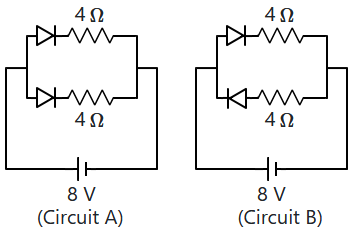Select Chapter Topics:
When semiconductor is heated, its resistance:
1.
decreases
2.
increases
3.
remains the same
4.
may increase or decrease depending on the semiconductor
Subtopic: Energy Band theory |
84%
From NCERT
Please attempt this question first.
Hints
Please attempt this question first.
The peak voltage in the output of a half-wave rectifier is \(30 ~\text{V}.\) The rms voltage of the output wave is: (assuming no distortion in wave)
1. \(\frac{30}{\sqrt2}~\text{V}\)
2. \(15 ~\text{V}\)
3. \(\frac{15}{\sqrt2}~\text{V}\)
4. \(10 ~\text{V}\)
1. \(\frac{30}{\sqrt2}~\text{V}\)
2. \(15 ~\text{V}\)
3. \(\frac{15}{\sqrt2}~\text{V}\)
4. \(10 ~\text{V}\)
Subtopic: Rectifier |
From NCERT
Please attempt this question first.
Hints
Please attempt this question first.
A p-n junction diode is connected in a series circuit with a battery (internal resistance \(0.5\) \(\Omega\)) and a \(5\) \(\Omega\) resistance. A current is found to pass through the circuit. If the polarity of the battery is reversed, the current drops to almost zero. This is because the resistance in the circuit is:
1. \(5\) \(\Omega\)
2. \(5.5\) \(\Omega\)
3. \(10\) \(\Omega\)
4. infinite
1. \(5\) \(\Omega\)
2. \(5.5\) \(\Omega\)
3. \(10\) \(\Omega\)
4. infinite
Subtopic: PN junction |
86%
From NCERT
Please attempt this question first.
Hints
Please attempt this question first.
The band gap between the valence band and the conduction band in a certain material is \(3\) eV. What is the longest wavelength of light that can create an electron-hole pair in the material, with the electron in the conduction band and the hole in the valence band? (Take \(hc\)=\(1240\) eV-nm.)
| 1. | \(414\) nm | 2. | \(300\) nm |
| 3. | \(830\) nm | 4. | \(207\) nm |
Subtopic: Energy Band theory |
87%
From NCERT
Please attempt this question first.
Hints
Please attempt this question first.
The current-voltage characteristic of an ideal \(\mathrm{p \text{-}n}\) junction diode is given by the graph as shown in the following figure:

This diode is connected with a resistance of \(5~\Omega\) in series with it as shown below:

Which of the following shows the dependence of the voltage \(V_{AB}\) and the current \(i\), when the diode is forward-biased? (\(V_{AB}\) in volt, \(i\) in ampere)

This diode is connected with a resistance of \(5~\Omega\) in series with it as shown below:

Which of the following shows the dependence of the voltage \(V_{AB}\) and the current \(i\), when the diode is forward-biased? (\(V_{AB}\) in volt, \(i\) in ampere)
| 1. | \(V_{A B}=i\cdot5+0.6\) |
| 2. | \(V_{A B}=i\cdot5-0.6\) |
| 3. | \(V_{A B}=i\cdot5+(0.6-5)\) |
| 4. | \(V_{A B}=i\cdot5+\left(0.6+5\right)\) |
Subtopic: PN junction |
From NCERT
To view explanation, please take trial in the course.
NEET 2023 - Target Batch - Aryan Raj Singh
Hints
To view explanation, please take trial in the course.
NEET 2023 - Target Batch - Aryan Raj Singh
Currents flowing in each of the circuits A and B respectively are:
(All the diodes are ideal)

1. \(1\) A, \(2\) A
2. \(2\) A, \(1\) A
3. \(4\) A, \(2\) A
4. \(2\) A, \(4\) A
(All the diodes are ideal)

1. \(1\) A, \(2\) A
2. \(2\) A, \(1\) A
3. \(4\) A, \(2\) A
4. \(2\) A, \(4\) A
Subtopic: PN junction |
88%
From NCERT
Please attempt this question first.
Hints
Please attempt this question first.
Suitable impurities are added to a semiconductor depending on its use. This is to:
| 1. | increase its electrical resistivity |
| 2. | increase its electrical conductivity |
| 3. | increase its life |
| 4. | enable it to tolerate higher voltage |
Subtopic: Types of Semiconductors |
89%
From NCERT
Please attempt this question first.
Hints
Please attempt this question first.
A semiconductor has a negative temperature coefficient of:
| 1. | resistance |
| 2. | conductance |
| 3. | both resistance and conductance |
| 4. | neither resistance nor conductance |
Subtopic: Energy Band theory |
77%
From NCERT
Please attempt this question first.
Hints
Please attempt this question first.
In a \(\text{p-n}\) junction, the potential barrier is due to the charges on either side of the junction, these charges are:
| 1. | majority carriers |
| 2. | minority carriers |
| 3. | fixed donor and acceptor ions |
| 4. | both (1) and (2) |
Subtopic: PN junction |
51%
From NCERT
Please attempt this question first.
Hints
Please attempt this question first.
Assuming that the diode is ideal, the output waveform for the circuit shown in figure is:


| 1. |  |
2. |  |
| 3. |  |
4. |  |
Subtopic: Rectifier |
From NCERT
Please attempt this question first.
Hints
Please attempt this question first.


